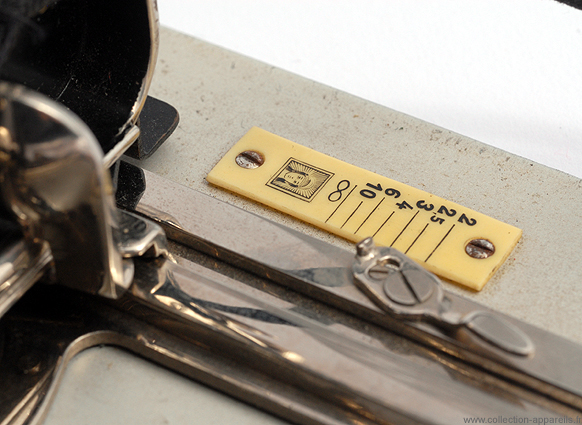|
Ernemann Heag XVI |
Manufactured or assembled in Germany from 1909 to 1918.
Index of rarity in France: Rare (among non-specialized garage sales)
Inventory number: 10166
See the complete technical specifications
Chronology of cameras Ernemann
The Ernemann Heag XVI, produced from 1909 to 1918, represents Ernemann's contribution to the intriguing but limited family of early 20th-century combined cameras, which were both true plate cameras and genuine folding cameras in a single camera.
The first combined cameras appeared in the USA starting in 1902 with companies like Manhattan Optical Co and Blair, followed by a few others including Kodak. In Europe, a few manufacturers followed suit: Wuensche for Girard's "Le Rêve" and the Nixe-Universal (1904), Nettel (Duplak 1911), and Ernemann with the Heag XVI. However, the ingenious concept of combined cameras did not enjoy long-lasting success, about a decade in America and a couple more in Europe. This difference in duration can likely be explained by the more extended use of glass plates on this side of the Atlantic. The decline of the combined camera formula can also be attributed to the progress in the quality of films and print paper. The fine detail achieved in photos on film was gradually approaching the results obtained with glass plates.
The Heag XVI, benefiting from Ernemann's excellent craftsmanship, consists of two parts: the actual camera, which can be used with 9 x 12 plates, and a removable back containing a No. 101 film, yielding images of 8.5 x 11.5 cm.
A black metal shutter, measuring 10 x 12 cm, is inserted into the back for film, allowing the sensitive surface to remain in the dark when separating the back and the camera. This makes it possible to take photos on plates between shots on film. A small black screen with an articulated ring is provided to maintain darkness over the film when the black shutter is removed for taking pictures on film. It is of the same width as the shutter and fits into the same slot but only penetrates about one and a half centimeters.
A distinctive feature of this camera is that the film and plates are at the same distance from the lens, which is generally not the case with other combined cameras that require the use of two different focus scales, one for plates and another for film.
The Heag XVI is of double extension, with an Ernemann shutter at 1/100 with pneumatic brake and a cable release, and an Ernemann Aplanat Symmetrical lens. It has both horizontal and vertical adjustments. It includes a clear viewfinder with a bubble level, two inactinic (non-light-sensitive) viewing ports on the back, and two tripod sockets with the standard Congress thread pitch to complete the equipment.
Traduction Manuel M
The back for film in roller accompanying this view camera is impressive. It is removable, allows set up of the frames for the use of glass plates, traditional support (though at the end of the lifetime) of sensitive surfaces at that time.
It also makes it possible with a foot to use a back ground-glass so doing the focusing, particularly at the time of a distance camera/subject lower than two meters. This adjustment of distance is possible by using the double extension of the bellows.
The 8 cm large film, once the onset stuck on the receiving reel out of wooden, allowed the realization of negative of 8 x 11.5 cm. Two red screens on the back of roll-film guided the operator during the change of view after exposure of film.
A removable metal part allows to possibly change back during the session of take of view or to use plates photographs on glass. There is nevertheless any security, in a direction or the other, in the event of handling error of this metal part.
The shutter of this camera is pneumatic. It is cocking by making a rotation (camaera of face in the opposite direction of the needles of a watch) with the selector shutter speed. It is actuated either manually directly on the camera or via a cable release which is unfortunately partially stripped here, traditional phenomenon of the ravage of time that one finds on much material of this time.
The shutter speeds go from the B to the 1/100 of second. The T is used the camera on foot jointly with a ground-glass to make the focusing.
The lens here is a “Aplanat Symétrical” without indication of the focal distance. The diaphragm of the lens allows aperture between F: 3 and F: 22. The plate lens holder allows vertical off-centrings, a mark is associated with the neutral position. A light side off-centring is also possible.
Composing could be made either directly on ground-glass (associate with the pose T), or in a more dynamic way by using the viewfinder associated with a spirit level which is close to the selector speed of the shutter (to be noted the possible rotation of this viewfinder for horizontal composing).
The major part of the items constituting this purpose is numbered what facilitates of it the location (standard and dates) in the production of this manufacturer.




Interesting links or bibliography :
Add a link or element of bibliography, a picture taken with this camera, a picture of box or an ads about this camera
Your photos taken with the same camera:
Cameras from Ebay France (Ernemann) (Uploaded each 3 hours)
 appareil photo à soufflet H . ERNEMANN DETECTIV 70,00 euros Finira le 23-07-2024 à 10:38:18 |







